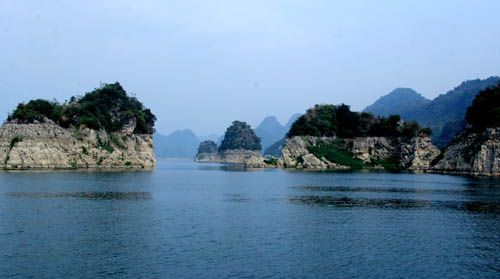

In the early morning, Bich Ha port was enveloped in mist. Our
boat rode upstream into the vast waters. Mr Nhan has spent nearly all his life
on the Da River. After years of saving, he now owns a new boat, offering tours
around the lake for tourists. At our request, he has prepared enough food for a
long trip on the lake.

In 2016,
the Prime Minister approved the planning of the Hoa Binh Lake national tourism
site.
Mr. Nhan said: "It was
not as hard as before to catch fish on Da River. The fish is clean and
delicious. Chicken and pork are also easily available.” He named a long list of
delicious specialties of the area, from grilled fish to grilled pork, rice
cooked inside a bamboo and forest vegetable.
The lake surface was calm in the morning. The farther we went, the stronger the wind was, and the lake opened up before us. Crystal clear water, blue sky, white clouds and green mountains combined into a breathtaking view.
After 30 minutes, our
ship docked near a mountain’s side to visit Sung island, one of the best scenic
spots on the lake. The island spans
Dozen minutes away from Sung island, we reached Ngoi lagoon, the most beautiful lagoon of the lake where the water is always calm. Nearby Ngoi hamlet remained the same, with poor but hospitable locals.
Hoa lake, located in Ngoi Hoa commune, Tan Lac district, is very deep. Locals said the lake is home to many species of fish, such as amur, dory, milkfish, and semilabeo notabilis.
On the mountain rising above the lake there lies the Khi (Monkey) cave which used to be inhabited by a lot of monkeys. However, few can be seen at present, and only their voices can be heard from inside the forest.
Around the lake, there are many hamlets which have become community-based tourist destinations thanks to their local cultural identities, including Phu hamlet (Toan Son), Mo and Ke hamlet (Hien Luong), Da Bia hamlet (Tien Phong), Lon spring (Tan Mai), and Mu and Go Lao waterfalls (Phuc San). Some hamlets in Dong Nghe, Suoi Nanh, Muong Tuong communes are still difficult to reach. Small streams flow into the lake, and fish abound in streams in Trung Hoa commune (Tan Lac), Ke hamlet (Hien Luong), Nanh estuary (Suoi Nanh).
Passing Nanh estuary, we went to Hang Mieng temple to offer incense to commemorate Mrs Dinh Thi Van, a Muong woman who had canvassed locals to help King Le Loi’s troops on Da river in the past.
Hang Mieng temple on the bank of Da river is located in Quang Minh commune, Van Ho district of Son La province, more than 50km away from Hoa Binh city’s Bich Ha port. The sacred temple is a must-go destination for tourists if they have time and want to pray for peace, children and luck./.
Le Chung